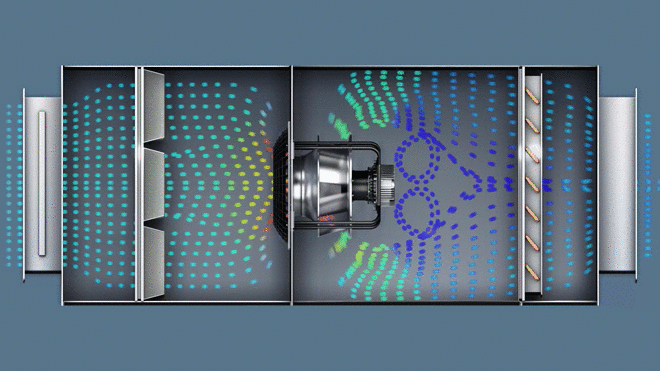Optimal aerodynamics is a key requirement for the success of both Mercedes-AMG Petronas Motorsport and ebm-papst. “Both know how important airflow is to performance”, explained Geoff Willis, Technology Director at Mercedes-AMG Petronas Motorsport. “Where our aerodynamic focus is on achieving high levels of consistent downforce, the focus on a fan is to improve airflow in the most efficient way possible”. Even though the Formula One team and ebm-papst have different challenges, the partners use similar approaches for implementing constant improvement. “The Formula One team and us use the same tools: on the one hand, numerical resources and software programs for simulation. On the other hand, experimenting with models and real products”, said Dr. Jürgen Schöne, Head of the Aerodynamics Department at ebm-papst in Mulfingen.
Even though the Formula One team and ebm-papst have different challenges, the partners use similar approaches for implementing constant improvement. “The Formula One team and us use the same tools: on the one hand, numerical resources and software programs for simulation. On the other hand, experimenting with models and real products”, said Dr. Jürgen Schöne, Head of the Aerodynamics Department at ebm-papst in Mulfingen.
Simulations: Airflow by numbers
Due to the great degree of freedom they provide, simulations are an important component of both partners’ development processes. ebm-papst uses simulation tools to compress the development period and discover technological potential that would otherwise remain hidden. “Numerics allow us to explore a much greater number of variations that we could ever hope to examine using an experimental approach. In this way, we have the opportunity to arrive at very different geometries and improvements,” explained Schöne.

Airflow simulation using a ventilation technology unit with RadiPac.
With CFD simulation, engineers at ebm-papst calculate the aerodynamic properties of impellers, for example. The RadiCal, a centrifugal fan that is ideal for many ventilation and air conditioning applications, was the first “synthetically developed” product created in that manner.
Simulations help Mercedes-AMG Petronas Motorsport to improve its understanding of the complex airflows around a Formula One car and study which aerodynamic consequences even the smallest changes have. The team uses the information to adjust the car optimally to the relevant track, for example. Willis explains: “The airflow over a Formula One car is very intricate and difficult to tame: swirling vortices that interact with each other, complicated flows around rotating wheels, and small changes in car attitude as it accelerates, brakes or turns. The key to success is having a thorough understanding of the many complex flow structures. This knowledge is built up using a combination of computational simulations (CFD) and experimental results from the wind tunnel and from the track.”
Experiments: The moment of truth
While Mercedes-AMG Petronas Motorsport goes to the wind tunnel or racetrack for its tests, the engineers from ebm-papst use combination tunnels in which both air performance and noise can be measured. “For us, the most important goal of experiments is verification of the values derived from simulations. After all, even today’s results are not perfect – and do not reflect the absolute truth,” said Schöne. “And we also conduct experiments in order to study the behavior of our fans in complex customer products or to take a closer look at their acoustics. There actually are some simulation tools for this purpose, but they are still in the development phase.”
“For us, the most important goal of experiments is verification of the values derived from simulations. After all, even today’s results are not perfect – and do not reflect the absolute truth.”
Dr. Jürgen Schöne, Head of the Aerodynamics Department at ebm-papst in Mulfingen
Results from the wind tunnel are just as important for Mercedes-AMG Petronas Motorsport as a means of verifying the findings of simulations. “Because of the complex nature of the flows involved, CFD sometimes struggles to give us a truly accurate simulation of what actually happens. The wind tunnel gives us a closer representation of what happens on the car”, explained Willis. The rules the Formula One team are subject to during their tests result in a major difference between the ways ebm-papst and Mercedes-AMG Petronas Motorsport work.

The engineers from ebm-papst run experimental tests to verify the results of their simulations.
Aerodynamics experts with experience
“We are limited by the regulations on the scale and wind speed we can test at, and a scale model at reduced speed will never fully replicate the physics of what happens at the track,” said Willis. This is why the Formula One team relies on experienced aerodynamics experts to interpret the findings of the wind tunnel experiments, simulations and the handful of test days they have available. At ebm-papst, the aerodynamics experts are usually asked to contribute their experience when it comes to adapting products to optimally serve customer applications. The better they pave the way, the more efficient the overall development process.
“The understanding of aerodynamics that ebm-papst have is one of the key reasons they are on top of their game with regards to cooling solutions.”
Dr. Jürgen Schöne, Head of the Aerodynamics Department at ebm-papst in Mulfingen
Willis describes how they are successful: “The understanding of aerodynamics that ebm-papst have is one of the key reasons they are on top of their game with regards to cooling solutions. Getting the aerodynamics right is crucial for a race car, but also for a fan so that it can be as efficient as possible”.

Leave a comment